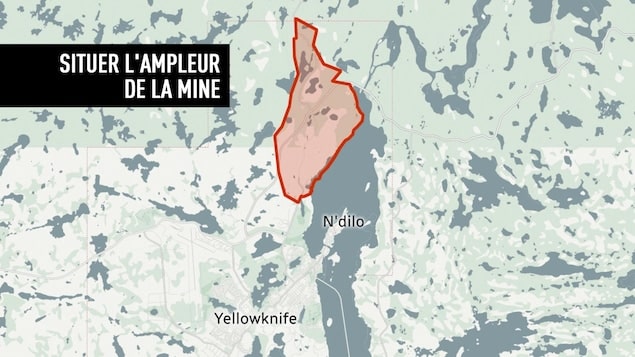While the miners saw it as the goose that laid the golden eggs, the mine looked more like a monster to the Yellowknife Dene, who saw it take over their ancestral lands and leave much suffering in its wake. .
” The Giant Mine is a monster that has threatened generations of Yellowknife Dene. It constantly changes form, but what it sows is always destruction and death. »
Among the most serious consequences was the death of a child, poisoned with arsenic, in 1951.
It is not the only victim of the contamination, because multiple episodes of arsenic poisoning and the death of almost an entire herd of cattle
are also part of the consequences of mining, as recalled by the First Nation in a November 2020 press release.

Situate the scale of the mine
Photo: Radio-Canada
Generations of children who grew up near the mine were told not to swim in the surrounding lakes and streams and not to eat the berries that grew there.
Arsenic trioxide generated by the Giant Mine also polluted the snow on Latham Island, used every spring as drinking water, from 1949 to 1952 and in 1954.
The Government of Canada’s primary response to this seasonal pollution of Yellowknife Dene water sources was to place advertisements in local newspapers, although at that time most Yellowknife Dene could not read
says a 2005 First Nation report (New window) (in English).
By polluting the environment, the mine also deprived the First Nation of its traditional way of life, since the elements that were central to the gathering were polluted, and the animals, hunted, poisoned.
By taking and contaminating traditional lands and resources, the Giant Mine has undermined the way of life of hunters, the Yellowknife Dene who were told Treaty 8 would protect them
adds the 2005 report.
This pollution is still having effects on the health and well-being of the Dene, says an October 2020 document (New window) (in English), who adds that the transfer of knowledge has also been undermined, in particular because of increased travel time and costs required to access food and medicinal plant harvesting areas considered safe
.
Arsenic trioxide
Arsenic trioxide is one of the waste products generated by mining. It is a solid that comes in the form of a white powder (dust) or transparent crystals and is odorless. It is mainly absorbed through the respiratory and digestive tracts, while the skin is a negligible route of absorption.
The lethal dose in humans is estimated to be approximately 50-300 mg (or 0.8-5 mg/kg bw), although severe effects have been observed following ingestion of doses of as little as 20 mg and people have survived oral doses of around 10 grams.
Arsenic is also considered carcinogenic, according to the International Agency for Research on Cancer.
Sources : Government of Canada; Commission for standards, equity, health and safety at work (Quebec).
In 2020, the Dene asked the federal government for a formal apology and compensation. To date, they haven’t received either, but in 2021, both sides signed deals (New window) intended to lead to this end.
Reference-ici.radio-canada.ca